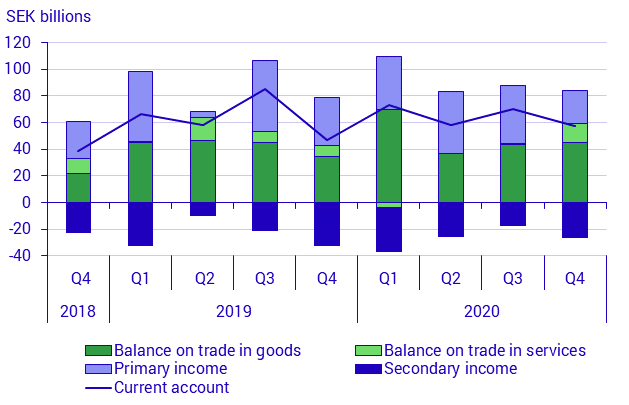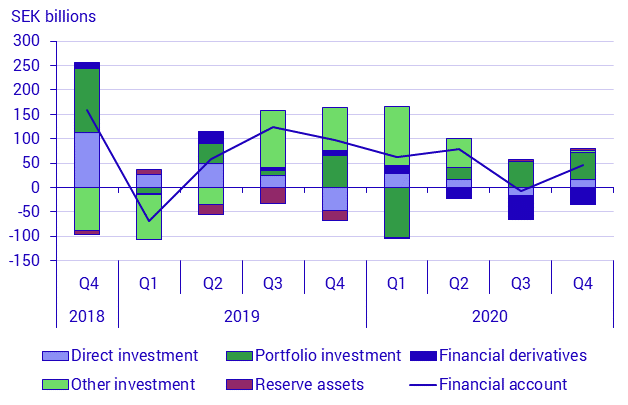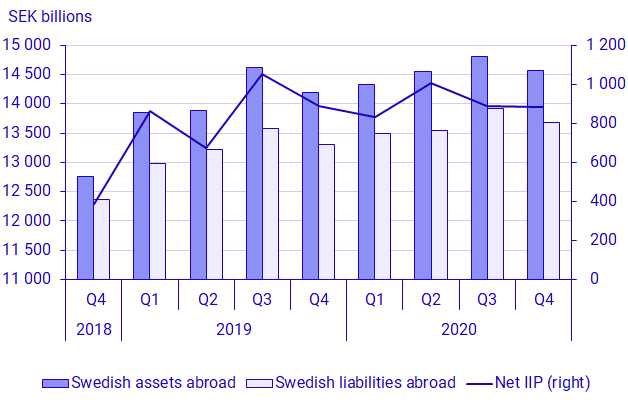Balance of payments, 4th quarter 2020. Corrected 2021-03-22
Decrease in imports of goods and services strengthened Sweden’s current account
Statistical news from Statistics Sweden 2021-03-05 9.30
The current account surplus was SEK 57.4 billion in the fourth quarter 2020, an increase of SEK 10.7 billion from the fourth quarter of 2019. Trade with goods and services was the main contributor to this increase, which was partially offset by investment income in the primary income.
A correction has been made 2021-03-22. The correction refers to foreign holdings in Swedish long-term debt securities regarding the fourth quarter of 2020.
The financial account shows that net lending with the rest of the world was SEK 45.2 billion in the fourth quarter. Sweden’s net external assets position, presented in the international investment position, was SEK 883.9 billion at the end of the fourth quarter of 2020.
What is the balance of payments?
The balance of payments is a statement of all Swedish transactions with the rest of the world. It presents exports and imports of goods and services, and includes a description of changes in financial assets and liabilities with the rest of the world. The balance of payments consists of the current account, the financial account, and the capital account. The component parts of the balance of payments and related terms are explained under Definitions and explanations, at the end of this item of statistics news.
Current account surplus as share of Sweden’s GDP increased
Sweden’s current account as a share of GDP widened in the fourth quarter, and amounted to 5.2 percent of Sweden’s GDP, calculated as an average over the last four quarters. This share has remained at similar levels since the third quarter of 2019.
Exports and imports of goods and services fell considerably in the second quarter, but have since recovered, which is most visible among goods. However, exports and imports of goods and services remained at a lower level than in the corresponding quarter a year ago.

Comparisons between periods in the current account are made using the corresponding quarter the previous year.
Trade in goods surplus increased
The balance on trade in goods recorded a surplus of SEK 45.2 billion in the fourth quarter of 2020, an increase of SEK 10.7 billion from the fourth quarter of 2019. Goods exports amounted to SEK 413.7 billion, down by SEK 7.3 billion compared with the corresponding quarter a year ago. Goods imports amounted to SEK 368.5 billion, down by SEK 18.0 billion in a corresponding comparison. Imports of goods fell more than exports of goods, which led to a strengthened balance on trade in goods.
Surplus in merchanting, which is included in the balance on trade in goods, decreased by SEK 2.5 billion compared with the first quarter of 2019. The surplus thus amounted to SEK 28.0 billion in the fourth quarter of 2020.
Services account surplus increased
The services account recorded a surplus of SEK 13.7 billion. This can be compared with a surplus of SEK 8.4 billion in the corresponding quarter last year. Services exports amounted to SEK 182.2 billion, down by SEK 9.4 billion compared with the fourth quarter of 2019. At the same time, import of services amounted to SEK 168.5 billion, down by SEK 14.7 billion in a corresponding comparison. Services imports decreased more than exports on services, which led to a strengthened services account.
Primary income surplus narrowed
Primary income, which consists mainly of compensation of employees and investment income, recorded a surplus of SEK 25.1 billion in the fourth quarter of 2020. This surplus narrowed by SEK 10.7 billion compared with the corresponding quarter a year ago. Investment income is the part of primary income that resulted in the decrease through a narrowed surplus. The surplus in investment income narrowed from SEK 33.6 billion in the fourth quarter of 2019 to SEK 20.4 billion in the fourth quarter of 2020. Surplus of compensation to employees remained relatively unchanged, while other primary income offset the decrease somewhat with a widened surplus.
Portfolio investment contributed a surplus of SEK 4.0 billion to investment income, a decrease of SEK 3.6 billion compared with the corresponding quarter a year ago. Investment income on direct investment contributed a surplus of SEK 17.8 billion, which is a decrease of SEK 7.9 billion in a corresponding comparison.
Secondary income deficit narrowed
Secondary income, which includes international cooperation and contributions to the EU, presented a deficit of SEK 26.5 billion. This deficit narrowed by SEK 5.4 billion compared with the corresponding quarter a year ago.
Net lending in the financial account
Net lending in the financial account was SEK 45.2 billion in the fourth quarter of 2020. Net lending and net borrowing refer to the overall balance on the financial account.
In the financial account, portfolio investment, direct investment, other investment, and reserve assets showed net lending in the fourth quarter of 2020. At the same time, financial derivatives show net borrowing in the quarter.

Swedish direct investment abroad increased
Net lending in direct investment amounted to SEK 16.0 billion in the quarter. Swedish direct investment in foreign assets increased by SEK 14.0 billion, while foreign direct investment in Sweden decreased by SEK 1.9 billion.
Swedish portfolio investments in foreign assets increased
Net lending in portfolio investments amounted to SEK 55.0 billion during the quarter. Swedish investors increased their portfolio investments in foreign assets by SEK 108.1 billion and foreign investors increased their portfolio investments in Sweden by SEK 53.0 billion.
Other investment decreased both in Sweden and abroad
Net lending in other investment corresponded to SEK 5.7 billion. Swedish other investment in foreign assets decreased by SEK 213.0 billion and foreign other investment in Sweden decreased by SEK 218.7 billion.
Financial derivatives and reserve assets
Net borrowing in financial derivatives amounted to SEK 35.2 billion. Reserve assets noted increased net lending corresponding to SEK 3.8 billion.
Net assets in Sweden’s international investment position decreased
Sweden’s net external assets position was SEK 883.9 billion, which means a decrease compared with the previous quarter, when net assets amounted to SEK 890.9 billion. Direct investment is the part that contributes the most to the decrease through decreased net assets.

Comparisons between periods in the international investment position are made using the previous quarter.
Swedish external liabilities decreased
Swedish external liabilities decreased by SEK 241.2 billion compared with the previous quarter and amounted to SEK 13 678.5 billion. Sweden’s external liabilities in other investment decreased, which was offset by an increase in external liabilities in portfolio investment. Liabilities in financial derivatives and direct investment noted decreases that were minor in this context.
Swedish external assets decreased
Swedish external assets decreased by SEK 248.0 billion compared with the previous quarter and amounted to SEK 14 562.5 billion. This change is largely due to decreased assets in other investment and direct investment, which was offset by increased portfolio investments. Financial derivatives and reserve assets showed minor decreases in assets.
Sweden’s largest net external assets in other investment
The largest net external assets were in other investment, reserve assets, and direct investment. The largest net liabilities were in portfolio investment.
Revisions
The time series for the Balance of Payments and the international investment position has been revised from Quarter 1 2017. New information about two major one-off items related to exports of data services and exports of research and development were added to the second and third quarters of 2019. This has led to an upward revision of the export of services.
The Balance of Payments adheres to a predetermined revision policy (see Section 2.3 of the 2021 Quality Declaration.
In a compilation of the balance of payments and the international investment position, data based on forecasts is used in some cases. The statistics will be updated as results are received. If new data is added or in the case of any methodological changes, further revisions are carried out as necessary.
Revisions carried out in connection with publication of the fourth quarter 2020 are listed in the tables on revisions by account item for the balance of payments and the international investment position, respectively.
Definitions and explanations
The current account and the financial account record real and financial transactions with regard to the rest of the world. Only proper transactions are recorded; value changes, such as exchange rate fluctuations are excluded.
The current account shows the trade in goods (foreign trade in goods), the trade in services (foreign trade in services), primary income (compensation to employees, investment income, other primary income), and secondary income (current transfers). Surplus and deficit in the current account refer to the difference between Sweden’s exports and Sweden’s imports. A positive outcome results in a surplus, while a negative outcome results in a deficit. Comparisons between periods in the current account are always made using the corresponding quarter the previous year, due to seasonal patterns in data.
The financial account consists of direct investment, portfolio investment, financial derivatives, other investment, and reserve assets. Sweden can acquire and dispose of financial assets abroad. All transactions during the quarter concerning external assets show Sweden’s change in net external assets. Sweden can also borrow and repay financial external liabilities. All transactions during the quarter concerning external liabilities show Sweden’s change in net external liabilities. The difference between Sweden’s change in net external assets and Sweden’s change in net external liabilities can be positive or negative, and shows net lending and net borrowing, respectively.
The capital account records Sweden’s capital transfers and transfers of non-financial assets with regard to the rest of the world. Compared with other parts of the balance of payments, amounts in the capital account are usually small.
The difference between Sweden’s financial external assets and liabilities position is the net of Sweden’s international investment position, which can be positive or negative.
An increase or decrease in assets describes Sweden’s external assets. An increase or decrease in liabilities describes Sweden’s external liabilities.
Merchanting, which forms a part of the trade in goods, refers to triangular trade in which goods are purchased and sold abroad without the good crossing a Swedish border.
Statistical Database
More information is available in the Statistical Database
Feel free to use the facts from this statistical news but remember to state Source: Statistics Sweden.
